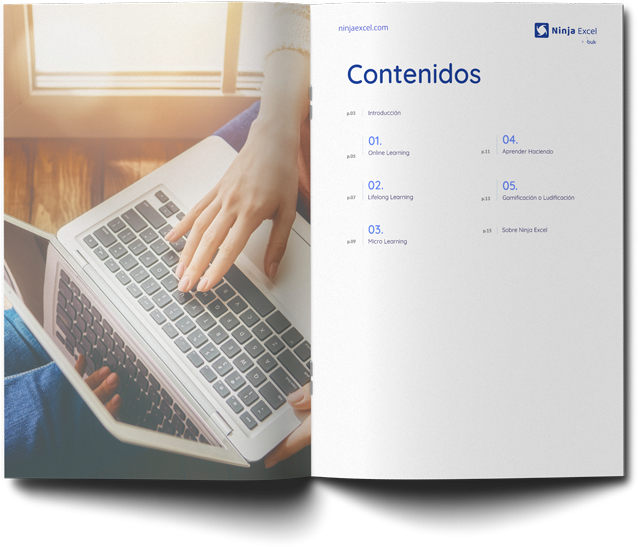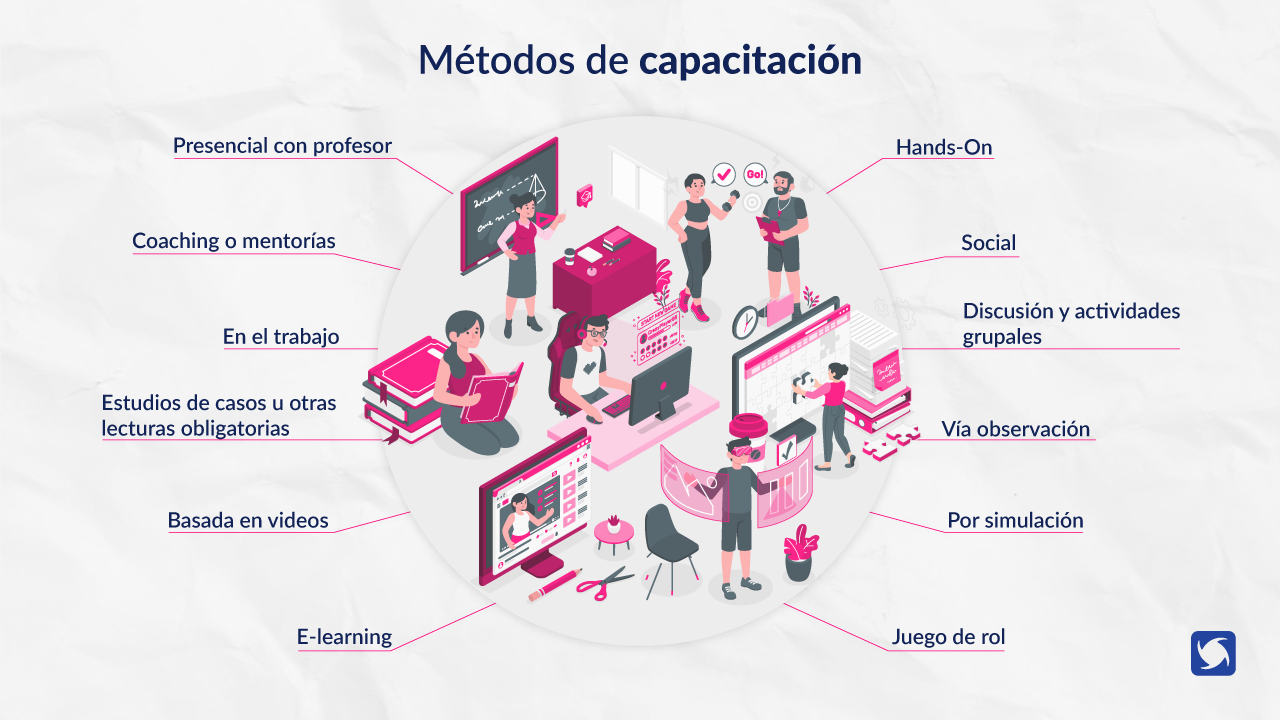6 most effective training methods to train your workers

If you are in planning mode, it is important to have different training methods in your portfolio. By analyzing all the options, you will be able better adjust your training plan. In this way, taking into account various variables, You will deliver training that is effective and with high adherence for your workers.
Have you heard the word Andragogy? This word of Greek origin means “man” and “guide” or “driving”. Basically, it is defined as all the techniques or methods that must be applied for adult education. The concept was used by Malcolm Knowles to affirm that children's learning is different from that of adults. “Pedagogy is teacher-centered learning, while andragogy is student-centered,” they state from The Classroom.
Why is this consideration important? It's because we are doing adult learning experiences. Therefore, resorting to “traditional methods”, such as mandatory in-person training, may not be the most effective (or maybe yes). It all depends on the target collaborator and their need.
But do not worry! If you are in training or training planning for your company's workers and you are evaluating different training methods, you came to the right place. The Ninja Excel team has prepared a complete article with various options in methods, advantages and application. So you can choose the best training of all. Let's get started!

Why is it important to choose a training method?
As we have mentioned, training is essential for the incorporation and retention of employees. In any scenario, the method is as important as the material. Therefore, in addition to the content, it is also relevant to define the training modality since you must detect which learning style fits your company. For Indeed, those in charge of training and education must observe the following:
Visual: learn by seeing and observing. Auditory: training by listening to information. Kinesic: learning through action or movement.

Ninja Fact: How can you get information that adds value to understanding this? The Training Needs Detection process will help you define it.
How to choose training methods?
To choose the best training method for your organization we have to balance three concepts: impact, understanding and implementation. And, according to Raven360, we must understand these elements when choosing the appropriate method. These would be:
- The objective will be adjusted according to the purpose. From Elm Learning exemplifies it with coaching. “It is perfect for teaching leadership, emotional intelligence or change management skills,” they say.
- Know if it already exists preferences or background of previous training modalities.
- If they differ learning styles between areas.
- Learning objectives and theme depending on the type of training to be carried out.
- Cost considered to invest.
- Target audience according to age and experience.
- Benefits for workers in the short and medium term.

The most used training methods
There are various training methods available in the market. Next, we will make a compilation of the main methods used for vocational training.
- In-person training with a teacher or instructor in-situ.
- E-learning.
- Training via observation.
- High-impact Hands-On (Practical training).
- Coaching or mentoring.
- On-the-job training.
- Discussion and group activities.
- Role playing game.
- Social training.
- Case studies or other required readings.
- Video-based training.
- Simulation training.
Whether a traditional or modern method, the key is to find the best one for what you need to train. Below, we will describe some of the most used training methods.
In-person training with instructor/facilitator
Typically, this type of training is led by a qualified instructor or professor. This type of training can be on or off the job. Typically, time is given at work where staff attend a presentation with activities, guides, analysis of case studies, among others.
Advantages of in-person training? You will ensure that all workers acquire the skills at the same time. Additionally, you can check on site compliance with training. Meanwhile, the Disadvantages of in-person training They can be: if it is external, pay the costs associated with the place. You may also incur travel expenses or catering.
On-the-job training
In English it is known as “On-the-Job”. It refers to training and coaching where employees actively participate in a work activity. “This is one of the most effective training methods for replacement planning,” they say from Elearning Industry.
Also known as training Hands-On –Practical training in Spanish– since, according to Edge Point, is an effective method in technical or mechanical work. For example, learning a product packaging process.
For Elearning Industry, it could be stressful for some people as errors can be frequent. However, support will always be the key.
Coaching or mentoring
Coaching or mentoring is a more personal training modality. “The coach inspires workers to maximize their personal and professional potential, in a way non-directive”, they say from Crearte Coaching.
Coaching is a great way to onboard new employees. Of course, according to Learn Worlds, “it requires a lot of time and many hours of work from more staff.” senior”.
Although coaching and on-the-job training may seem similar, coaching:
- Focuses on the mentor-mentee relationship.
- It's more inspiring.
- It is more likely to make the worker feel comfortable asking questions.
"5 training trends for your 2023 planning"
Training via observation (Job Shadowing)
This type of training. makes new workers observe what other colleagues or experts are doing. According to Learn Worlds, “in this training and learning environment, new employees must follow and observe more experienced others, accompanying or 'shadowing' them in staff meetings, their daily work, and other activities.”
This type of training is useful, for example:
-
- Restaurant workers.
- Medical professions.
- Manufacturing jobs.
- Administration functions.
- Expert commercial areas.

Interactive training
This training brings together the aforementioned methods. In this type of training we include the form of simulations, scenarios, role plays, questionnaires or games. Some of the modalities included in this training method are:
-
- Role playing game: A facilitator moderates various roles according to certain scenarios that the job provides. “It is especially effective for client training or interaction with clients, as it explores difficult situations in a controlled environment,” they say from Learn Worlds.
- Simulations: Simulations are ideal for learning specialized and complex skills, such as medicine or aviation. “Virtual reality scenarios can be excellent simulation tools,” they say.
For ELearning Industry, this type of training makes workers are more committed and can retain what they have learned. “However, it can be time-consuming when done in person, especially when learners require regular feedback from a content expert,” they say.
E-learning or online training
eLearning, or online training, has become one of the most effective solutions for training. Among the main characteristics of online training are;
-
- The collaborators They can visit the contents at their own pace. They decide where they can start.
- Usually no need for a teacher or instructor. It may be the company's decision to do a hybrid modality.
- An undetermined number of workers can be trained at the same time. This is a fundamental aspect when you must choose a particular methodology.
- No investment in additional equipment is needed.
- HE can complement with other materials such as reading, videos, questionnaires, tests, among others.
- Many trainings have monitoring or traceability systems. This way, as a training manager, you can see the progress and status of your team.
Benefits of applying training methods
The benefits of choosing good training methods are varied. In fact, according to Business and Company, to train a company's staff, beyond their characteristics, "they provide means that allow better learning and faster development of knowledge."
The same portal lists the following benefits in defining and applying training methods:
-
- Provide staff with opportunities for continued development, both in their positions and in other roles for which they may be considered in the future.
-
- Prepare employees for the execution of specific tasks that are key within the organization.
-
- Promote a more pleasant work environment in which workers feel more motivated and a greater sense of belonging is generated.
-
- Improve the communication process within the company at all levels.
-
- Reduce expenses for equipment maintenance and production waste.
-
- Reduce absences and constant staff turnover.
-
- Mitigate accidents that can occur in the workplace.
As you have read, choosing training methods or modalities will help you better enhance your team's learning.

Nicolas Cortes
Periodista y editor de contenidos en Ninja Excel con 5 años de experiencia en tratar temas de recursos humanos y capacitación corporativa. Me apasiona investigar y crear contenido práctico y relevante que ayude a los profesionales a mejorar sus habilidades y conocimientos en el ámbito laboral. Si buscas información clara, concisa y enfocada en resultados, ¡estás en el lugar correcto!
